
The Gulf of Thailand, historically known as the Gulf of Siam, is a shallow inlet in the southwestern South China Sea, bounded between the southwestern shores of the Indochinese Peninsula and the northern half of the Malay Peninsula. It is around 800 km (500 mi) in length and up to 560 km (350 mi) in width, and has a surface area of 320,000 km2 (120,000 sq mi). The gulf is surrounded on the north, west and southwest by the coastlines of Thailand, on the northeast by Cambodia and the Mekong Delta region of Vietnam, and opens to the South China Sea in the southeast.

Trawling is an industrial method of fishing that involves pulling a fishing net through the water behind one or more boats. The net used for trawling is called a trawl. This principle requires netting bags which are towed through water to catch different species of fishes or sometimes targeted species. Trawls are often called towed gear or dragged gear.

Marine conservation, also known as ocean conservation, is the protection and preservation of ecosystems in oceans and seas through planned management in order to prevent the over-exploitation of these marine resources. Marine conservation is informed by the study of marine plants and animal resources and ecosystem functions and is driven by response to the manifested negative effects seen in the environment such as species loss, habitat degradation and changes in ecosystem functions and focuses on limiting human-caused damage to marine ecosystems, restoring damaged marine ecosystems, and preserving vulnerable species and ecosystems of the marine life. Marine conservation is a relatively new discipline which has developed as a response to biological issues such as extinction and marine habitats change.
The Experimental Oculina Research Reserve preserves the Oculina Banks, a reef of ivory bush coral off the coast of Fort Pierce, Florida. Oculina varicosa is a U.S. National Marine Fisheries Service species of concern. Species of concern are those species about which the U.S. Government's National Oceanic and Atmospheric Administration (NOAA), National Marine Fisheries Service, has some concerns regarding status and threats, but for which insufficient information is available to indicate a need to list the species under the U.S. Endangered Species Act (ESA).

Koh Rong is an island in Preah Sihanouk province, Cambodia. It is the second largest island of Cambodia. The word Rong might refer to an old term for "cave" or "tunnel". It can also refer to the Old Khmer word for shelter, adding up to Shelter Island.

Unsustainable fishing methods refers to the use of various fishing methods to capture or harvest fish at a rate that is unsustainable for fish populations. These methods facilitate destructive fishing practices that damage ocean ecosystems, resulting in overfishing.
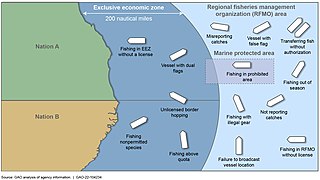
Illegal, unreported and unregulated fishing (IUU) is an issue around the world. Fishing industry observers believe IUU occurs in most fisheries, and accounts for up to 30% of total catches in some important fisheries.

Hol Chan Marine Reserve is a marine reserve close to Ambergris Caye and Caye Caulker, off the coast of Belize. It covers approximately 18 km² (4,448 acres) of coral reefs, seagrass beds, and mangrove forest. Hol Chan is Mayan for "little channel".
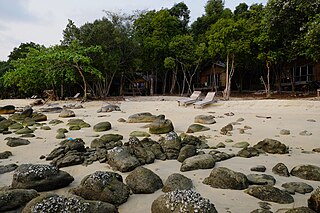
Koh Kong, or Outer Koh Kong, is an island in the Gulf of Thailand, in the coastal waters of Cambodia, around 10 km (6 mi) south of Koh Kong town, as it is part of Koh Kong Province. It is Cambodia's largest island.
Koh Seh is a Cambodian island located in the Gulf of Thailand, inside Ream National Park, Sihanoukville province. It lies 1.5 km (1 mi) south of Koh Thmei and around 9 km (6 mi) south of the main-land of Sihanoukville's Ream commune. A 4.3 km (3 mi) wide sound separates it from Phu Quoc. "Koh Seh" means Horse Island. Less than 400 meters south-west of Koh Seh lies the tiny islet of Koh Ky.

The environmental impact of fishing includes issues such as the availability of fish, overfishing, fisheries, and fisheries management; as well as the impact of industrial fishing on other elements of the environment, such as bycatch. These issues are part of marine conservation, and are addressed in fisheries science programs. According to a 2019 FAO report, global production of fish, crustaceans, molluscs and other aquatic animals has continued to grow and reached 172.6 million tonnes in 2017, with an increase of 4.1 percent compared with 2016. There is a growing gap between the supply of fish and demand, due in part to world population growth.
Destructive fishing practices are fishing practices which easily result in irreversible damage to habitats and the sustainability of the fishery ecosystems. Such damages can be caused by direct physical destruction of the underwater landform and vegetation, overfishing, indiscriminate killing/maiming of aquatic life, disruption of vital reproductive cycles, and lingering water pollution.

The spiny seahorse, also referred to as the thorny seahorse, is a small marine fish in the family Syngnathidae, native to the Indo-Pacific area. It is classified as a Vulnerable species by the IUCN.

Kadmat Island, also known as Cardamom Island, is a coral island belonging to the Amindivi subgroup of islands of the Lakshadweep archipelago in India. Measuring 9.3 kilometres (5.8 mi) in length, the island has a lagoon with a width of 1.5 kilometres (0.93 mi) covering an area of 25 square kilometres (9.7 sq mi). The ecological feature of the island is of coral reef with seagrass, and marine turtles which nestle here. The Ministry of Environment and Forests (India) has notified the island as a marine protected area for ensuring conservation of the island's animal, plant, or other type of organism, and other resources.

Preah Sihanouk, also Sihanoukville, is a province (khaet) in southwest Cambodia on the Gulf of Thailand. The provincial capital, also called Sihanoukville, is a deep water port city and a steadily growing and diversifying urban center on an elevated peninsula.
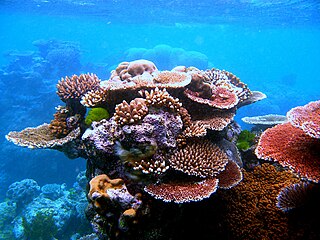
Coral reef protection is the process of modifying human activities to avoid damage to healthy coral reefs and to help damaged reefs recover. The key strategies used in reef protection include defining measurable goals and introducing active management and community involvement to reduce stressors that damage reef health. One management technique is to create Marine Protected Areas (MPAs) that directly limit human activities such as fishing.
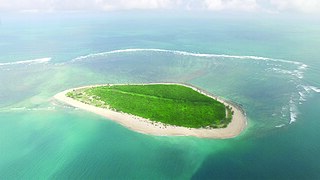
The Primeiras and Segundas Archipelago is a chain of 10 sparsely inhabited barrier islands and two coral reef complexes situated in the Indian Ocean off the coast of the Zambezia Province of Mozambique. The islands lie in two groups along the western side of the Mozambique Channel with the Segundas Islands located near the coastal city of Angoche.

Amanda Vincent is a Canadian marine biologist and conservationist, one of the world's leading experts on seahorses and their relatives. She currently holds the chair of the IUCN SSC Seahorse, Pipefish and Seadragon Specialist Group and is the marine representative on the IUCN's International Red List Committee as well as being the chair of its Marine Conservation Committee. She previously held the Canada Research Chair in Marine Conservation at the UBC Institute for the Oceans and Fisheries at the University of British Columbia (UBC), Canada from 2002 to 2012. Vincent co-founded and directs Project Seahorse, an interdisciplinary and international organization committed to conservation and sustainable use of the world's coastal marine ecosystems. In 2020 she became the first marine conservationist to win the world's leading prize for animal conservation, the Indianapolis Prize.
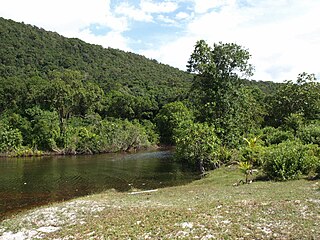
Koh Rong Sanloem is an island off the coast of Sihanoukville, Cambodia, 4 km (2 mi) south of Koh Rong. It is around 9 km (6 mi) long, 4 km (2 mi) wide and 1 km (1 mi) wide at its narrowest point. Its distance from the local port of Sihanoukville is 25 km (16 mi) (beeline) and 23 km (14 mi) (beeline) from the Serendipity/Ochheuteal beach pier. The word "Sanloem" translates to: 1. drowsiness and to: 2. far out and hard to discern, in a wider sense. Inconsistencies on how to spell the island's name in its Latinized version date back to the 19th century. The first controversial spelling variants were issued by map makers during French rule. Alternatives have since become widespread and are in common usage. Often confusion ensues as Google Maps offers the phonetically most consistent variant, whereas Google Search redirects to an alternative.
Koh Ach Seh is a Cambodian island located off the country's southern coast in the Gulf of Thailand. "Koh Ach Seh" translates to 'Horseback Riding Island', however the name is popular evolving to just Koh Seh - Horse Island. The island is part of Kep Archipelago, and is being administered by Kep Province.
















